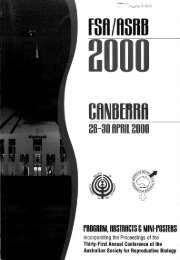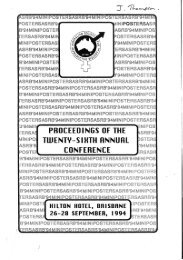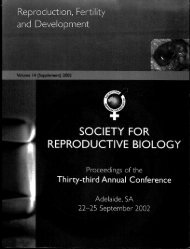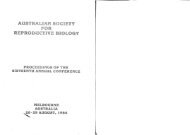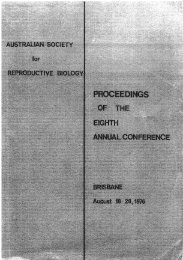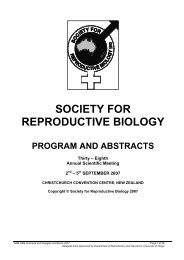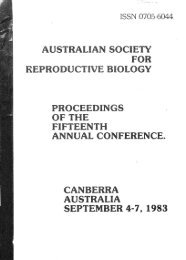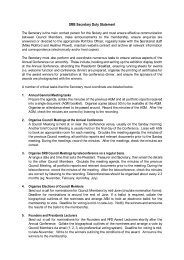N OCIETY' - the Society for Reproductive Biology
N OCIETY' - the Society for Reproductive Biology
N OCIETY' - the Society for Reproductive Biology
Create successful ePaper yourself
Turn your PDF publications into a flip-book with our unique Google optimized e-Paper software.
NEW GENETICALLY TARGETTED SENSORS FOR THE CONFOCAL IMAGING OFINTRACELLULAR Ca 2 + AND pH IN LIVING CELL SYSTEMSDavid A. Williams, David N. Bowser, Angela M. Reilly, Rekha Panchal, Megan L. Smart, RobertNicholls and Steven PetrouConfocal and Fluorescence Imaging Group, Department of Physiology, The University ofMelbourne, Parkville, 3052, Australia.The majority of cellular processes are sensitive to changes in Ca 2 + and/or W ion concentration. As such,study of <strong>the</strong> regulation of intracellular, particularly intraorganellar, Ca 2 + and pH is of fundamentalimportance to <strong>the</strong> understanding of most cell systems. Two experimental strategies directly explore <strong>the</strong>interorganellar ion concentrations in living cells. The first involves loading of intact cells with membranepermeantfluorophores, with subsequent quenching or removal of potentially confounding cytosolicfluorescence. This strategy has largely focussed on Ca 2 + and <strong>the</strong> mitochondria and while it has had somesuccess (Bowser et al., 1998), <strong>the</strong>se fluorescence techniques are difficult and <strong>the</strong> attribution of results tospecific cell locations has not always been unambiguous. The second approach has also focussed on Ca 2 + andinvolves intracellular targeting of <strong>the</strong> luminescent, Ca 2 +-sensitive protein "aequorin", to specific organellesand has been in use <strong>for</strong> a number of years. Aequorin is a very sensitive Ca 2 + sensor and its properties havebeen thoroughly categorised well be<strong>for</strong>e its use in "targeted mode". However, it has always been difficult toimage (its luminescence producing less that one photon per molecule) and has suffered from difficultiesinvolved in calibrating <strong>the</strong> light emission in terms of absolute [Ca 2 +J.Developments in molecular biological syn<strong>the</strong>sis have recently provided Ca 2 +and pH sensors, that offer majoradvantages over chemically syn<strong>the</strong>sized Ca 2 + sensors and targeted Ca 2 + sensors with sub-optimalcharacteristics. "Cameleons" are genetically engineered protein sensors of free Ca 2 +comprised of tandemfusions of a blue or cyan mutant of fluorescent protein (GFP), calmodulin, calmodulin-binding protein M13and an enhanced green or yellow emitting GFP. Following <strong>the</strong> binding of Ca 2 +, calmodulin wraps around <strong>the</strong>M13 domain, <strong>the</strong>reby bringing <strong>the</strong> two flanking GFPs closer toge<strong>the</strong>r. This proximity allows <strong>for</strong> Resonance.Energy Transfer (RET) of <strong>the</strong> emitted energy (from <strong>the</strong> "donor") directly into <strong>the</strong> excitation of <strong>the</strong> second"acceptor" GFP. The degree to which RET occurs represents a direct, ratiometric measure of free Ca 2 +concentration. The Ca 2 + affinity of <strong>the</strong> fusion protein is not fixed to that of <strong>the</strong> native calmodulin segment.Point mutations in this sequence with standard molecular genetic techniques have allowed fine-tuning of <strong>the</strong>Ca 2 +affinities from as low as approximately 10- 8 M to up to 10- 2 M, suitable <strong>for</strong> different locations (i.e. high<strong>for</strong> <strong>the</strong> cytosol, nucleus or mitochondria, and low <strong>for</strong> ER, Golgi or plasmalemma). The pH dependency ofvarious GFP mutants, in particular, that of enhanced yellow fluorescent protein (EYFP), with <strong>the</strong> highestpK'a of <strong>the</strong> mutants, provides exciting possibilities <strong>for</strong> targeted pH measurements.These sensors can be produced in situ by gene transfer of plasmid DNA into a number of cell types with avariety of well-established transfection techniques. Targeted chameleons can also be packaged intorecombinant adenoviruses (Adeasy system) to allow <strong>for</strong> infection of primary cultured adult cardiac myocytes.This system has already been used in our laboratory to create a recombinant aden0 viral plasmid containing<strong>the</strong> SERCA2A gene and GFP <strong>for</strong> successful infection of adult cardiac myocytes. Protein-based sensors aredirected to <strong>the</strong>ir intended cellular location by 'tar~eting seque.nces' that are encoded within <strong>the</strong> sequence of aprotein. For nuclear localization <strong>the</strong> targeting sequence can be placed within a·protein or at <strong>the</strong> N or Cterminus and directs protein translocation to <strong>the</strong> nucleus of <strong>the</strong> cell, Similarly, <strong>for</strong> mitochondrial targeting aleader sequence directs <strong>the</strong> translocation of <strong>the</strong> protein to <strong>the</strong> mitochondria. ill <strong>the</strong> case of <strong>the</strong> endoplasmicreticulum (ER) <strong>the</strong> actions of a signal peptide and ER retention sequence toge<strong>the</strong>r act to direct and <strong>the</strong>nretain a protein within <strong>the</strong> ER. Proteins lacking a targeting sequence are retained within <strong>the</strong> cytoplasm and,thus, 'targeted' to <strong>the</strong> cytoplasm. Our present work is characterising existing protein construct Ca 2 +-sensors<strong>for</strong> <strong>the</strong> ER and cytosol, and developing alternative versions with modified Ca 2 + affinities and differentlocalisation sequences, particularly <strong>for</strong> use in <strong>the</strong> mitochondria and at <strong>the</strong> plasma membrane.Bowser, D.. Minamikawa, T., Nagley, P & Williams, D. (1998) Biophysical Journal. 75: 2004-2014.TISSUE RECOMBINANT TECHNOLOGYGail P. RisbridgerMonash Institute of Reproduction and Development, Monash Medical Centre, 246 Clayton Road,Clayton, Victoria, 3168.The technique of constructing tissue recombinants was pioneered by Kratochwil in <strong>the</strong> 1970's. Heused TFM mice to demonstrate that regression of mouse mammary glands during embryogenesis, isan androgen regulated process. Since <strong>the</strong>n, a number of studies in <strong>the</strong> mammary gland, prostate orvagina have used tissue recombinants to reveal. The nature of <strong>the</strong> cell - cell interactions between <strong>the</strong>epi<strong>the</strong>lium and mesenchyme and <strong>the</strong> requirement <strong>for</strong> receptors on cell type. The purpose of thisworkshop is to describe <strong>the</strong> technique of constructing tissue recombinants using <strong>the</strong> prostate as amodel system. The development of <strong>the</strong> prostate is under androgenic control, but this talk will focuson <strong>the</strong> use of tissue recombinants to demonstrate a requirement <strong>for</strong> estrogens. Using <strong>the</strong> a estrogenreceptor knock-out (a ERKO) mouse model, tissue recombinations demonstrated that <strong>the</strong> presenceof ER a in <strong>the</strong> stroma and <strong>the</strong> epi<strong>the</strong>lium is essential to obtain a full response to estrogeniccompounds such as diethylstilbestrol. The preparation and use of tissue recombinants is a uniqueand powerful method of dissecting <strong>the</strong> interplay between <strong>the</strong> stroma and epi<strong>the</strong>lium in mediatinghormonal responses by <strong>the</strong>se organs. As <strong>the</strong> development of new mouse models of targeteddisruption of steroid receptors and steroidogenic enzymes became available, we can define <strong>the</strong>cellular mechanisms of all types of hormone responses.3637



